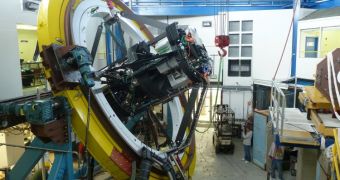One of the most important components of the Dark Energy Survey, the DECam camera, has just been completed, and is now ready for shipment to the Blanco Telescope, at the Cerro Tololo observatory, in the Chilean Andes.
The entire telescope will be shut down starting next Monday, so that the necessary work can begin on upgrading it with the new camera. The instrument's main function is to provide astrophysicists with a window into the most elusive and important components of the Universe – dark energy.
Efforts to do so at BIanco are being conducted by an international team of 120 scientists, who will all participate in the upgrade process. The project is headed by University of Chicago cosmologist Josh Frieman. He is also based at the Fermi National Accelerator Laboratory, in Batavia, Illinois.
With DECam installed on the observatory, the group is hoping that it will be able to conduct some investigations that will clear some of the mystery associated with dark energy. The latter is believed to be the force responsible for conducting the ever-accelerating expansion of the Universe.
But this is not just any regular camera. Tipping the scale at around 5 tons, this scientific instrument has a resolution of about 570 megapixels. Its creation was managed by Fermilab expert Brenna Flaugher.
“We started talking about the project at the very end of 2003. We eventually got the funding in place from the Department of Energy about 2008 and we finished building the camera about a year ago,” the researcher explains.
“The most exciting time will be when we take our first snapshots of the night sky,” Frieman goes on to say. It is currently estimated that the camera's first survey of the night sky – covering a total of about 300 million galaxies – will last about 5 years, MEDILL reports.
If successful, the Dark Energy Survey will solve what is perhaps the biggest mystery in all of physics today. Figuring out what dark energy is, how it acts, and how it first appeared could also reveal the answer to fundamental questions about the Big Bang and the Universe as a whole.
In addition, astrophysicists will also be able to determine with a fairly high degree of accuracy whether we are living in just a small part of a Multiverse or not.
The DECam will attempt to use an observations technique called gravitational lensing – using galaxies as large lenses to see what's behind them – to conduct the survey.

 14 DAY TRIAL //
14 DAY TRIAL //